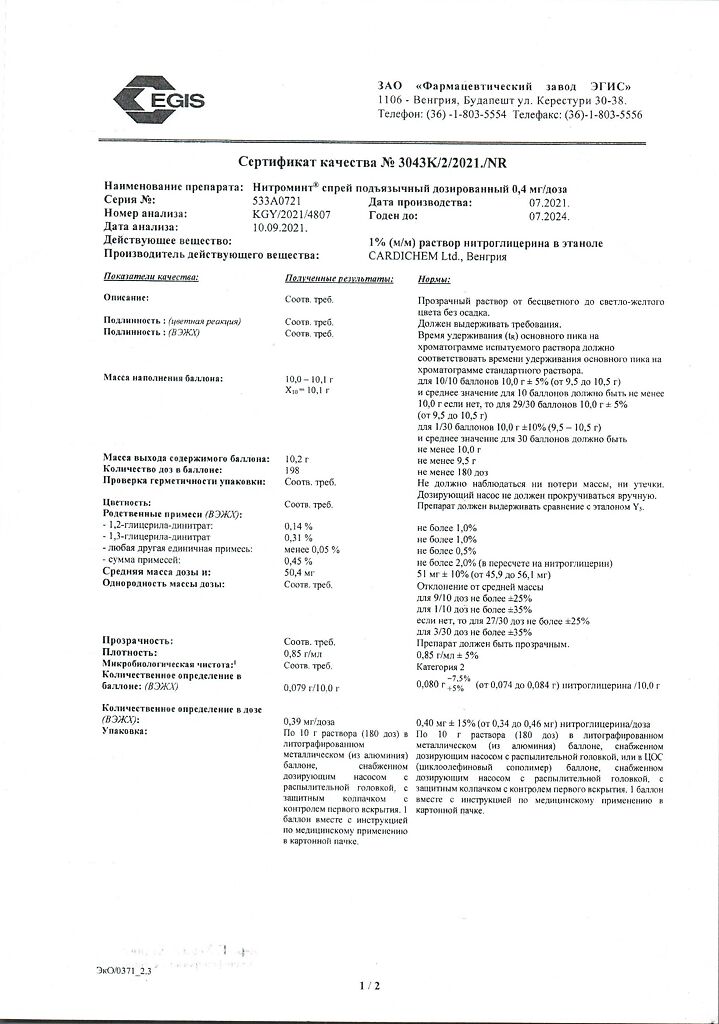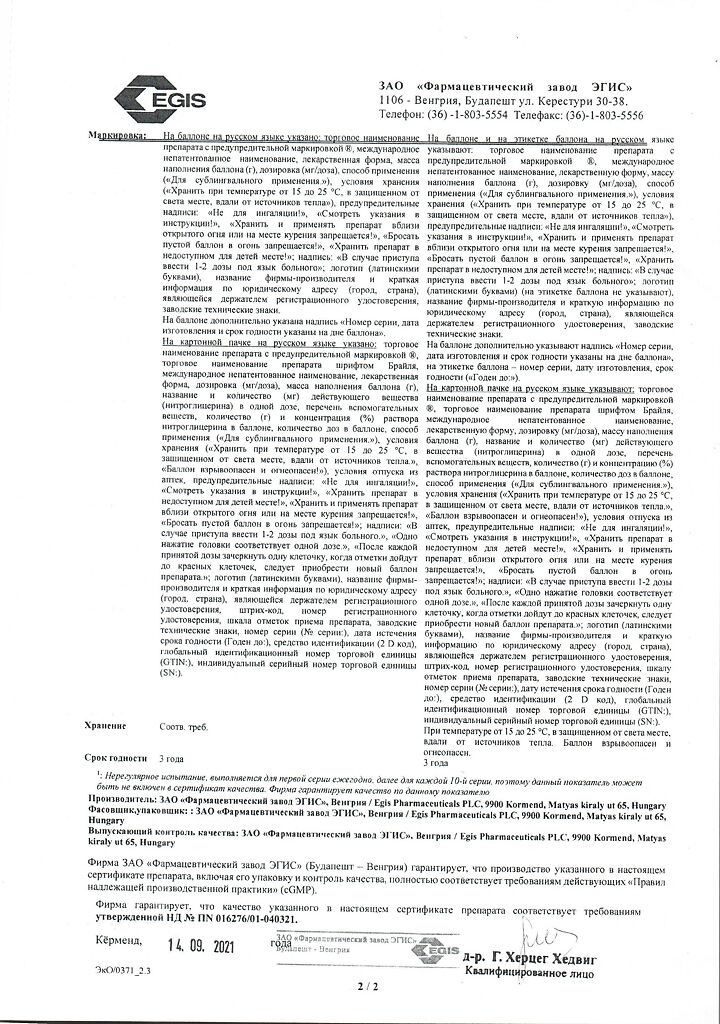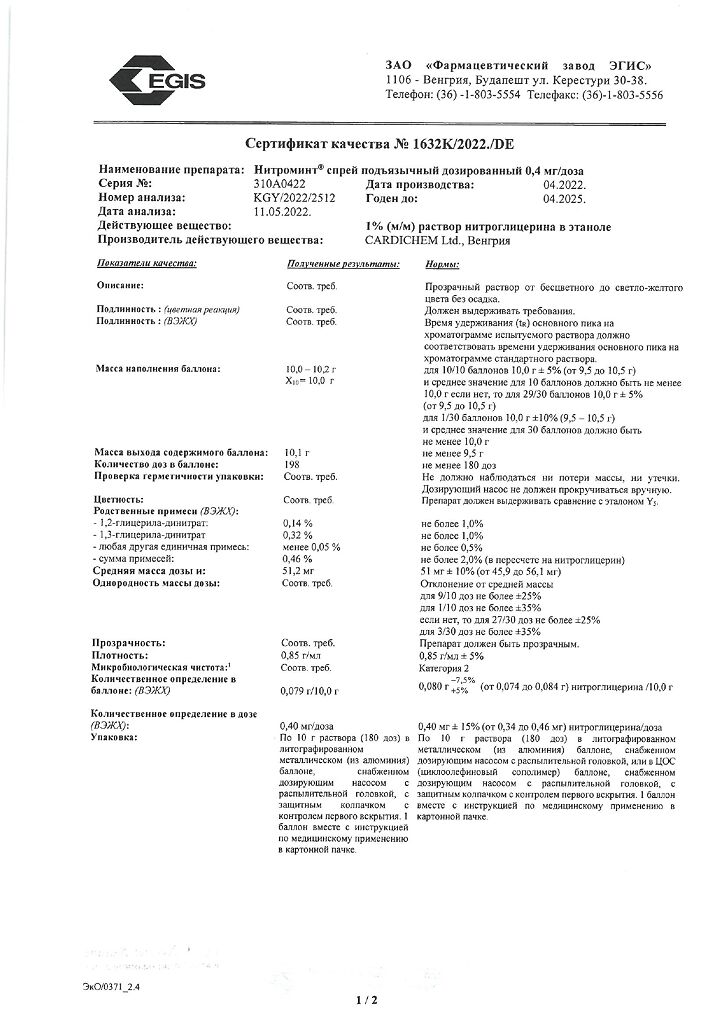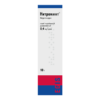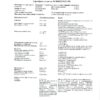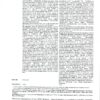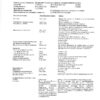No products in the cart.
Nitromint, sublingual spray 0.4 mg/dose 180 doses 10 g
€4.57 €3.81
Out of stock
(E-mail when Stock is available)
Description
Pharmgroup:
Vasodilating agent – nitrate.
Pharmic action:
Nitromint is a peripheral vasodilator with predominant effect on venous vessels, an antianginal drug. Nitroglycerin is an organic nitrogen-containing compound with predominant venodilatory action.
The effects of nitroglycerin are due to the ability to release from its molecule nitric oxide, which is a natural endothelial-relaxing factor. Nitric oxide activates the enzyme guanylate cyclase, which leads to an increase in intracellular levels of cGMP, this prevents the penetration of calcium ions into the smooth muscle cells and causes them to relax.
The relaxation of smooth muscle in the vascular wall causes vasodilation, which reduces venous return to the heart (preload) and the resistance of the large circulatory system (postload). This reduces heart function and myocardial oxygen demand. Dilation of the coronary vessels improves coronary blood flow and promotes its redistribution to areas with reduced blood supply, which increases oxygen delivery to the myocardium.
The reduction of venous return leads to reduction of filling pressure, improvement of subendocardial blood supply, reduction of pressure in the small circle of circulation and regression of symptoms in pulmonary edema. Nitroglycerin has a central inhibitory effect on sympathetic vascular tone, depressing the vascular component of pain syndrome formation. Nitroglycerin also relaxes smooth muscle cells of bronchi, urinary tract, gall bladder, bile ducts, esophagus, small and large intestine as well as their sphincters.
The action of Nitromint starts quickly, the effect develops within 1-1.5 minutes and lasts about 30 minutes.
Pharmacokinetics:
Absorption
Nitromint® aerosol is rapidly and completely absorbed from the oral cavity into the systemic bloodstream. Bioavailability of Nitromint® is 100% when administered sublingually, because in this case nitroglycerin is not metabolized during “first passage” through the liver. Cmax in plasma is reached after 4 min.
Distribution
Binding to plasma proteins is 60%.
Circulating nitroglycerin is firmly bound to erythrocytes and accumulates in vascular walls.
Metabolism
Fast metabolized with the participation of nitrate reductase, with the formation of di- and mononitrates (only isosorbide-5-monononitrate is pharmacologically active), the final metabolite is glycerol.
Elimation
After drug administration under tongue T1/2 from blood plasma is 2.5-4.4 min. Total clearance is 25-30 l/min.
It is excreted mainly with urine as metabolites, less than 1% is excreted unchanged.
Indications
Indications
— angina pectoris (relief and prevention of attacks, including before physical activity);
– acute left ventricular failure (as part of combination therapy).
Pharmacological effect
Pharmacological effect
Pharmaceutical group:
vasodilator – nitrate.
Pharmaceutical action:
Nitromint is a peripheral vasodilator with a predominant effect on venous vessels, an antianginal drug. Nitroglycerin is an organic nitrogen-containing compound with a predominant venodilating effect.
The effects of nitroglycerin are due to the ability to release nitric oxide from its molecule, which is a natural endothelial relaxing factor. Nitric oxide activates the enzyme guanylate cyclase, which leads to an increase in intracellular cGMP levels, this prevents the penetration of calcium ions into smooth muscle cells and causes them to relax.
Relaxation of the smooth muscles of the vascular wall causes vasodilation, which reduces venous return to the heart (preload) and resistance of the systemic circulation (afterload). This reduces the work of the heart and the myocardium’s need for oxygen. Dilatation of coronary vessels improves coronary blood flow and promotes its redistribution to areas with reduced blood supply, which increases oxygen delivery to the myocardium.
A decrease in venous return leads to a decrease in filling pressure, improved blood supply to the subendocardial layers, a decrease in pressure in the pulmonary circulation and regression of symptoms of pulmonary edema. Nitroglycerin has a central inhibitory effect on the sympathetic tone of blood vessels, inhibiting the vascular component of the formation of pain. Nitroglycerin also relaxes the smooth muscle cells of the bronchi, urinary tract, gallbladder, bile ducts, esophagus, small and large intestines, as well as their sphincters.
The action of Nitromint begins quickly, the effect develops within 1-1.5 minutes and lasts about 30 minutes.
Pharmacokinetics:
Suction
Nitromint® aerosol is quickly and completely absorbed from the oral cavity into the systemic circulation. The bioavailability of Nitromint is 100% when administered sublingually, because in this case, nitroglycerin is not metabolized during the “first pass” through the liver. Cmax in blood plasma is reached after 4 minutes.
Distribution
Plasma protein binding is 60%.
Circulating nitroglycerin is tightly bound to red blood cells and accumulates in the walls of blood vessels.
Metabolism
It is quickly metabolized with the participation of nitrate reductase, with the formation of di- and mononitrates (only isosorbide-5-mononitrate is pharmacologically active), the final metabolite is glycerol.
Removal
After taking the drug sublingually, T1/2 from blood plasma is 2.5-4.4 minutes. General ground clearance – 25-30 l/min.
It is excreted mainly in the urine in the form of metabolites, less than 1% is excreted unchanged.
Special instructions
Special instructions
Nitromint® enhances the excretion of catecholamines and vanillinmandelic acid in the urine.
While using the drug, the patient should avoid drinking alcohol.
Use in pediatrics
The drug is contraindicated for use in children and adolescents under 18 years of age, because There is insufficient data on the safety of Nitromint in this category of patients.
Impact on the ability to drive vehicles and operate machinery
At the beginning of treatment, it is necessary to refrain from driving vehicles and engaging in potentially hazardous activities that require increased concentration and speed of psychomotor reactions. In the future, the degree of restrictions is determined individually for each patient.
Active ingredient
Active ingredient
Nitroglycerine
Composition
Composition
1 dose:
– nitroglycerin (in the form of 1% solution) 400 mcg
Excipients:
ethanol,
propylene glycol.
Pregnancy
Pregnancy
During pregnancy and lactation, the use of the drug Nitromint is possible under strict medical supervision in cases where the expected benefit of therapy for the mother outweighs the potential risk for the fetus or infant.
It is not known whether nitroglycerin is excreted in breast milk.
Contraindications
Contraindications
— shock;
— collapse;
– age up to 18 years;
– hypersensitivity to nitroglycerin and other organic nitrates.
The drug should be used with caution in acute circulatory failure accompanied by severe arterial hypotension (systolic blood pressure less than 90 mm Hg), orthostatic hypotension, hemorrhagic stroke, acute myocardial infarction and chronic heart failure with low left ventricular filling pressure, hypertrophic cardiomyopathy, severe renal and/or liver failure, severe anemia and thyrotoxicosis, alcoholism, epilepsy, traumatic brain injury, intracranial hypertension, angle-closure glaucoma (risk of increased intraocular pressure), migraine.
Side Effects
Side Effects
From the cardiovascular system: dizziness, headache, tachycardia, fever; decrease in blood pressure; rarely (especially with overdose) – orthostatic collapse, cyanosis.
From the digestive system: dry mouth; rarely – nausea, vomiting, abdominal pain.
From the side of the central nervous system: weakness, rarely – anxiety, psychotic reactions, lethargy, disorientation.
Allergic reactions: rarely – skin rash, itching.
Local reactions: skin hyperemia, burning sensation under the tongue.
Other: rarely – blurred vision, hypothermia, methemoglobinemia.
Interaction
Interaction
Other vasodilators and antihypertensive drugs (beta-blockers, slow calcium channel blockers), ACE inhibitors, antipsychotics, tricyclic antidepressants, MAO inhibitors, phosphodiesterase inhibitors, procainamide and ethanol may enhance the hypotensive effect of Nitromint®.
Nitromint® enhances the effect of dihydroergotamine and reduces the effectiveness of heparin.
Overdose
Overdose
Symptoms: headache, decreased blood pressure, orthostatic hypotension, reflex tachycardia, dizziness, facial flushing, vomiting and diarrhea, asthenia, increased drowsiness, feeling hot. At excessively high doses (more than 20 mg/kg), methemoglobinemia, cyanosis, dyspnea and tachypnea, and orthostatic collapse are observed.
Treatment: in mild cases – transfer the patient to a lying position with raised legs; in severe cases – symptomatic and supportive therapy aimed at eliminating intoxication and shock (including replenishment of blood volume, administration of norepinephrine (norepinephrine) and/or dopamine). The use of epinephrine (adrenaline) is contraindicated.
When methemoglobinemia develops, the following antidotes and treatment methods can be used:
1. Ascorbic acid – 1 g in the form of sodium salt orally or intravenously.
2. IV methylene blue in a dose of up to 50 ml of 1% solution.
3. Toluidine blue IV, first dose 2-4 mg/kg, then repeatedly 2 mg/kg.
4. Oxygen therapy, hemodialysis, blood transfusion (exchange).
Manufacturer
Manufacturer
EGIS, Hungary
Additional information
| Manufacturer | EGIS, Hungary |
|---|---|
| Medication form | hyoid spray |
| Brand | EGIS |
Related products
Buy Nitromint, sublingual spray 0.4 mg/dose 180 doses 10 g with delivery to USA, UK, Europe and over 120 other countries.


